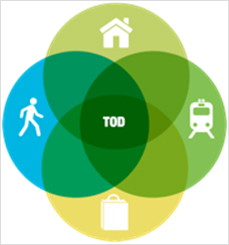Transit Oriented Development Plan For Kochi Metro
 Kochi is one of the largest cities in the state of Kerala with extensive waterways. In the last decade, the city and immediate suburbs have witnessed construction of skyscrapers but with limited demographic intensity. Also, new business and economic centres such as the SMART City, Info Park, various townships, LNG Terminal etc have come up indicating the shift from a low intensity to a more high intensity development. These economic centres are expected to generate a quantum of employment which would require an equally relative number of housing and other amenities. However, since these are located in a larger city region, there is a need for a rapid mass transit system. Hence, to minimize the distance between housing and job locations and promote compact development, there is a need to integrate the same with innovative mass transportation systems.
Kochi is one of the largest cities in the state of Kerala with extensive waterways. In the last decade, the city and immediate suburbs have witnessed construction of skyscrapers but with limited demographic intensity. Also, new business and economic centres such as the SMART City, Info Park, various townships, LNG Terminal etc have come up indicating the shift from a low intensity to a more high intensity development. These economic centres are expected to generate a quantum of employment which would require an equally relative number of housing and other amenities. However, since these are located in a larger city region, there is a need for a rapid mass transit system. Hence, to minimize the distance between housing and job locations and promote compact development, there is a need to integrate the same with innovative mass transportation systems.
 Kochi Metro Rail Limited (KMRL) with the vision to provide a mass public transportation system, through government and international funding is implementing “Kochi Metro”, the rail based transportation system to cater to the ever increasing demand for an efficient public transport system. Phase I of the metro system is being implemented from Aluva in the North of the city region to Petta in the South running a length of 25.6 km approximately. With 22 stations planned across the corridor, the rail system runs across the immediate suburbs of the Kochi city and passes through high retail areas
Kochi Metro Rail Limited (KMRL) with the vision to provide a mass public transportation system, through government and international funding is implementing “Kochi Metro”, the rail based transportation system to cater to the ever increasing demand for an efficient public transport system. Phase I of the metro system is being implemented from Aluva in the North of the city region to Petta in the South running a length of 25.6 km approximately. With 22 stations planned across the corridor, the rail system runs across the immediate suburbs of the Kochi city and passes through high retail areas
The Context
The Client – Kochi Metro Rail Limited (KMRL) through National Transportation Planning and Research Centre (NATPAC) has engaged UMTC to prepare Transit Oriented Development Plan ("TOD") along the proposed metro corridors in Kochi City. The TOD plan would, inter alia, identify all the options available for high density development along the transit corridors and at transit stations recommending implementation of these measures on priority up to 26 km. The project shall also assess revenue that may be derived from the transit oriented development planning initiatives along the corridor through various value capture techniques.
Services:
UMTC with its core expertise in Urban Development is entrusted with identifying all options available for high density development along the metro transit corridor and in and around metro stations. The plan reviews and assesses existing situations in the corridor based on extensive GIS based mapping for the entire delineated TOD Influence area. Identification of various potential development mechanisms such as new development, in-fill, redevelopment etc. and policy recommendations on potential development control regulations is a part of the scope. This includes identification of sites and land parcels with high potential for property development. UMTC has developed a property development strategy defining optimal best use mixes for various station areas. Multi-modal integration, non-motorized transport, accessibility and direct connectivity are other important components included as part of the TOD Plan, which will be put to action at the soonest. The TOD plan also estimates infrastructure demands for future scenarios with respect to utility requirements. This plan will also discuss the implementation strategy of these measures on priority as per market demand, and a broad revenue estimation that may be derived from transit oriented development planning initiatives along the corridor. The initiative would take shape through various value capture techniques that will be undertaken. The mandate also includes preparation of a conceptual station area plan, focusing on the station’s integration and accessibility with the surrounding areas. A conclusion shall be drawn with a policy level document for TOD and various action points as part of the TOD ACTION PLAN to be taken up by KMRL.